ASLA's 125th: A Brief History of the ASLA New York Chapter
1/21/2024Leave a Comment

Battery Park and lower Manhattan in 1944 / Courtesy of NYC Parks
By Diane Sferrazza Katz and Jennifer Nitzky, FASLA
When ASLA was founded in 1899, eight New York landscape architects were a part of the original organization. Nearly all of the annual meetings of the organization were held in New York City in those early years.
In 1914, when it was determined that other chapters should be able to join the National Organization, the ASLA New York Chapter was founded with 18 members.
The original executive committee was led by President James L. Greenleaf, Vice President Charles N. Lowrie and Treasurer A.F. Brinkerhoff. In addition to these three officers, there were 15 other members of the Executive Committee.
It seems natural that New York is one of the original chapters of the society since it is often thought that Central Park represents the founding of the profession.
Beatrix Farrand was the only woman on the founding committee. She came from a prominent New York family and began practicing in 1895. Her works include private gardens, botanical gardens, college campuses, and public parks, including The Rose Garden at the New York Botanical Garden, which still blooms in its original glory today.
She was the inspiration for so many women landscape architects and paved the way for the New York Chapter and landscape architecture in general. Learn more about Beatrix and other prominent female New York members.
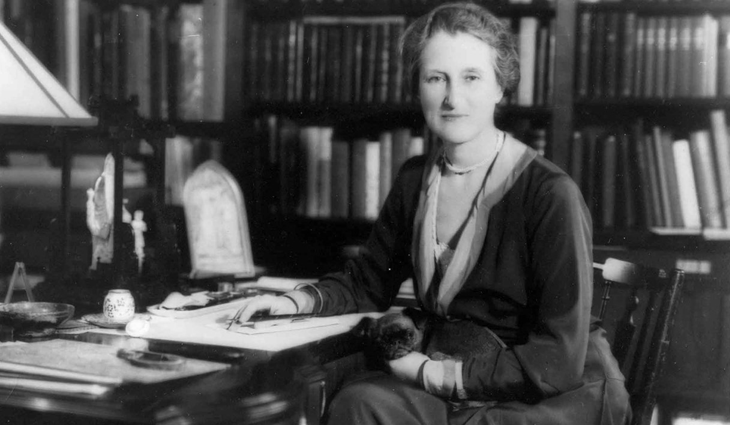 Beatrix Farrand at her desk. / Courtesy of the National Park Service.
Beatrix Farrand at her desk. / Courtesy of the National Park Service.
ASLA-NY has been an important part of the transformation of New York for over one hundred years. In 1923, the New York Chapter, led by then Secretary Clarence Fowler, opposed a proposal to tunnel under Central Park for a new subway line, which would have destroyed many trees and caused costly rebuilding efforts of the park.
In June 1930, the city embarked on the Great Lawn Project, a plan presented by ASLA-NY, to replace a large reservoir that pre-dated Central Park, transforming it into a great oval of turf for recreational purposes. ASLA-NY has seen the city through the creation of NYC parks as part of the New Deal, two Worlds Fairs, the completion of pocket parks in vacant lots, and the creation of conservancies and alliances to preserve and maintain our most important green spaces.
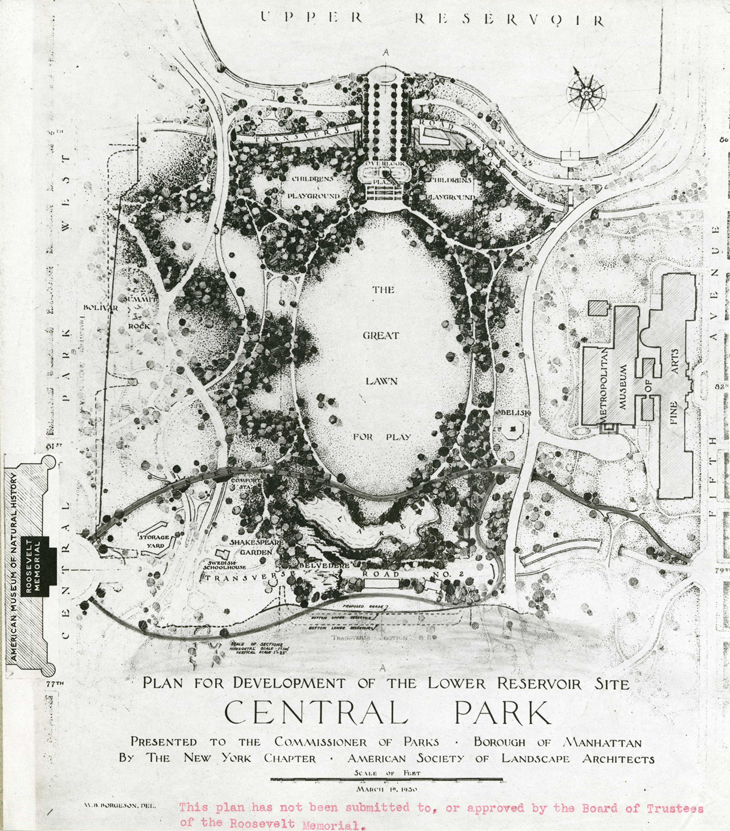
The Great Lawn of Central Park seen in a 1933 plan / Courtesy Central Park Conservancy
In 1961, the New York State Council of Landscape Architects was established to represent all licensed landscape architects in New York State at the request of the New York State Board for Landscape Architecture.
In the 1960s, there were not many landscape architecture schools in major urban cities in America. With a desire to expand the profession to a more diverse student population, ASLA asked M. Paul Friedberg to start a program for Landscape Architecture at City College of New York (CCNY) specifically to attract minority students.
In the early days of the program, the school attracted many women landscape architecture students. Today, CCNY provides a Master’s of Landscape Architecture program that prides itself in student diversity as its mission is “to prepare students to be leaders in the field of landscape architecture through innovative research and practice in urban ecological design, planning, and policymaking.”
The chapter’s dedication and advocacy in 2013-14 led by Adrian Smith, FASLA, persuaded the NYC Department of Buildings to change their requirements to allow landscape architects to sign and submit permit applications. This was a huge win for practitioners in NY as it started to put us on even ground with engineers and architects.
In 2014, ASLA-NY celebrated 100 years with a commemorative video. The film reveals some of the important moments in history, like the chapter’s involvement in the development of the Great Lawn in Central Park. It also demonstrates the importance of membership and how the organization strengthens the profession.
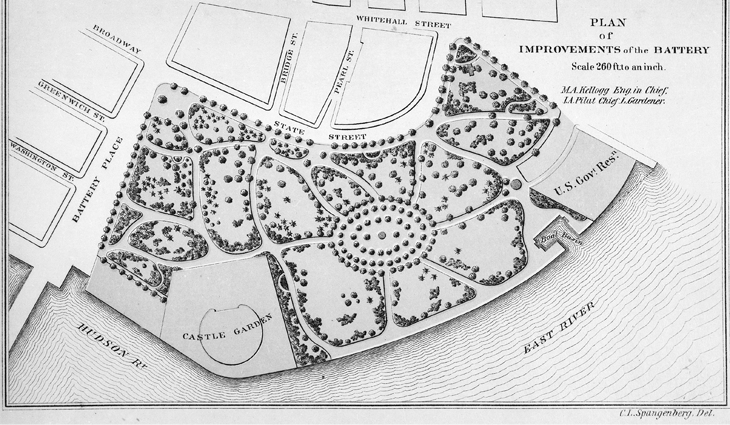
The 1870/71 Plan of Improvements of the Battery by Chief Landscape Gardner I. A. Pilat. Courtesy NYC Parks.

Anaerial view of Battery Park in 1953 / Courtesy of NYC Parks
When the chapter was founded in 1914 its mission was to serve and advocate for members practicing and studying the profession in the NY Metro and Long Island area. The Chapter has grown to over 500 members and while continuing with its original mission, the chapter now additionally serves its members and the greater landscape architect community by providing continuing education, inspiring the next generation, widening awareness of the profession and highlighting the works of the profession through its annual awards program.
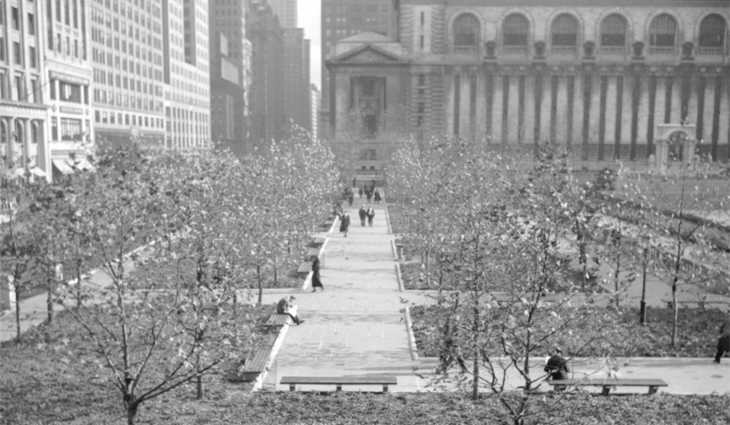 Bryant Park looking East from 42nd St. in 1935 / Courtesy NYC Parks
Bryant Park looking East from 42nd St. in 1935 / Courtesy NYC Parks
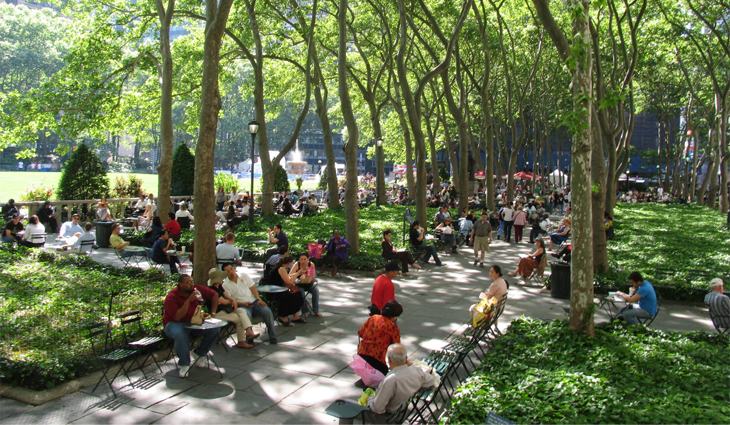 Bryant Park in 2014 / Jennifer Nitzky, FASLA
Bryant Park in 2014 / Jennifer Nitzky, FASLA
New York is home to many iconic places that were designed by landscape architects -- from Central Park to the High Line, from Times Square to the many coastal resilience projects along our shores. The New York Chapter has and will always strive to provide its members with a network that allows them to grow professionally and advance the visibility of the profession.
Founding Members of the New York Chapter
(* denotes ASLA Fellow)
- President – James L. Greenleaf *
- Vice President – Charles N. Lowrie *
- Secretary-Treasurer – A. F. Brinckerhoff *
- John Brinley *
- Harold A. Caparn *
- Noel Chamberlain
- Marian Coffin *
- Beatrix Farrand *
- Clarence Fowler *
- Charles Leavitt *
- Samuel Parsons *
- Carl Pilat *
- Rollin Saltus
- Prentice Sanger
- Richard Schermerhorn *
- Ferruccio Vitale *
- Downing Vaux *
- Ralph Weinrichter *
Resources:
- Transactions of the American Society of Landscape Architects : from its inception in 1899 to the end of 1908 by American Society of Landscape Architects; Caparn, Harold A; Pray, James Sturgis, 1871-; Vaux, Downing; 1912
- Transactions of the American Society of Landscape Architects, 1909-1921; The American Society of Landscape Architects, 1922.
- The Cultural Landscape Foundation
- Planting the Seeds for the "Great Lawn", Central Park History
- The Bernard and Anne Spitzer School of Architecture, The City College of New York, Master of Landscape Architecture
Diane Sferrazza Katz is the Executive Director of the ASLA New York Chapter. Jennifer Nitzky, PLA, FASLA, ISA, is Design Principal, Studio HIP, and Vice President, Fine Arts Federation of NY
.png)

.png)
.png)
.png)
.png)
.png)
(1).png)

